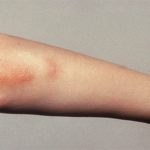Most cases of MAS are preceded by infection, often a viral infection such as herpes. The pathway to the overexpansion of hemophagocytic macrophages can be understood by first comparing it to the normal immune response, in which NK cells comprise the first line of defense against the pathogen. Antigen-specific cytotoxic CD8 cells become important in subsequent stages of the immune response, killing off the infected cells and secreting multiple cytokines that stimulate macrophages to also kill infected cells. During the normal contraction of the immune response, most of these macrophages undergo apoptosis.
However, as seen in both HLH and MAS, low initial activity of the NK cells, due to mutations in the gene encoding perforin or some other genetic defects affecting the cytolytic pathway, leads to an increased viral load in the early stages of infection. This triggers increased expansion of CD8 cells and sets up a chronic stimulation of macrophages and monocytes, which continue to secrete pro-inflammatory cytokines, including tumor necrosis factor–α, interleukin (IL)-6 and others. Animal studies are now providing support for the central role of cytotoxic CD8 cells secreting interferon gamma. Surplus production of cytokines causes over-activation of the phagocytic macrophages, wreaking havoc on the hemapoietic cells lines and depleting them in the bone marrow.
When you see cytopenias in a patient with systemic [juvenile rheumatoid arthritis], low fibrinogen, and a high ferritin level, this should raise concerns of MAS.
—James Verbsky, MD, PhD
Comparison to SJIA Flares
Many of the symptoms of advanced MAS can resemble flares of rheumatic disease, so diagnosis can be difficult. However, there are important differences that can help clinicians sort out their patients’ symptoms. In both SJIA and MAS, for example, patients have fever, lymphadenopathy, and hepatosplenomegaly. That is where the resemblance ends, noted Drs. Grom and Verbsky. Whereas white blood cell counts, platelets, erythrocyte sedimentation rate, and fibrinogen will typically be elevated in patients having a SJIA flare, these levels are decreased in MAS. SJIA patients’ fevers tend to be quotidian, while those in MAS patients tend to be persistent. The characteristic evanescent rashes seen in SJIA also differ from those in MAS patients, where the rashes are petechial. In addition, ferritin and triglyceride levels will be high in patients with MAS.3
During his presentation, Dr. Verbsky described how his team at the Medical College of Wisconsin used these differences to diagnose two unusual cases. The first was a 12-year-old boy initially admitted to their hospital with the diagnosis of SJIA, due to his fevers of 103–104º, rash, and stiff and swollen joints, as well as other complaints. As is common with these cases, the physicians had started pulse steroid therapy for three days, then switched the patient to oral corticosteroids and methotrexate. Although the boy continued to have intermittent fevers, his rash improved with the corticosteroids, and he was discharged.
